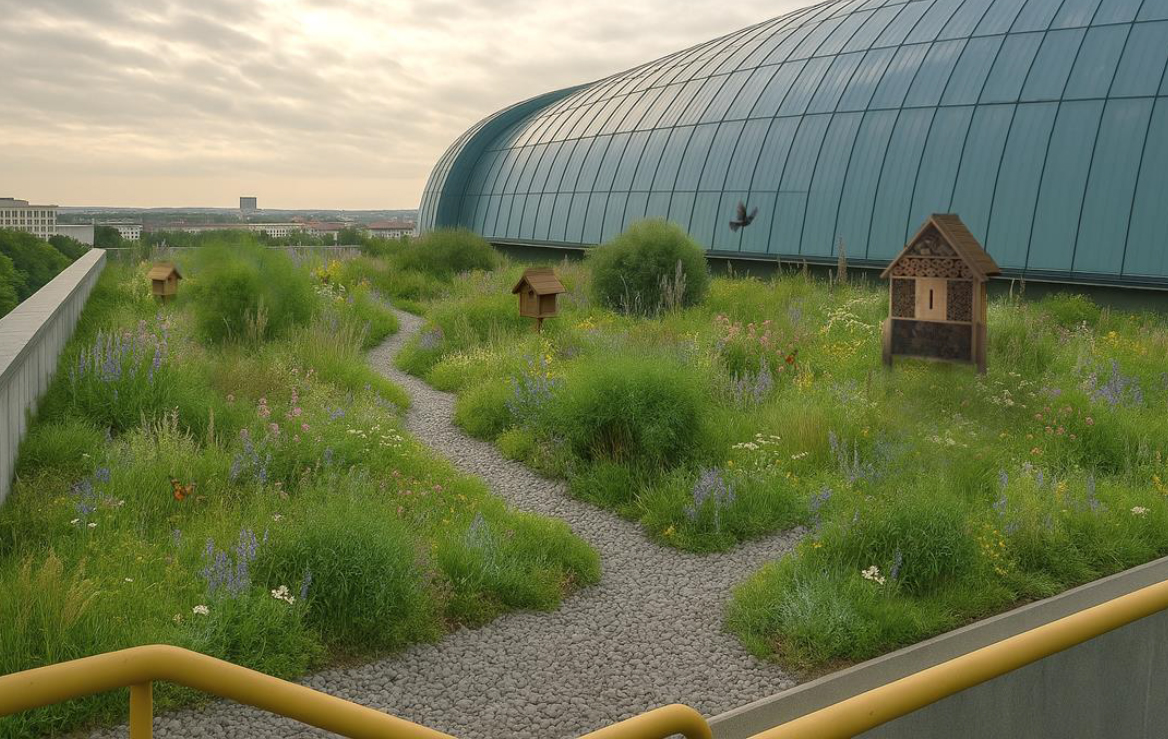From the 10th to the 12th of April, at FIL – Lisbon International Fair, TEKTÓNICA once again established itself as the privileged meeting point for the construction, architecture and sustainability sectors. With more than 300 companies present and a strong international representation, the 2025 edition was the stage for innovation, technical solutions and qualified networking. For three days, it was possible to find out about trends, materials and technologies that are transforming the construction sector at national and global level.
As part of its participation, the National Association of Green Roofs (ANCV) hosted the seminar ‘Green Roofs and Resilience in Cities’ on the 11th of April. An hour dedicated to presenting practical solutions and projects that demonstrate how green infrastructures are taking centre stage in adapting cities to climate change, promoting biodiversity, energy efficiency and improving the quality of urban life.
Among the cases presented, the intervention of landscape architect Vera Clara, head of the Design and Construction of Green Spaces Department at Horto do Campo Grande, stood out, with a project developed for a shopping centre in Lisbon, a paradigmatic example of the conversion of waterproof areas into green surfaces with added ecological value.

Developed by Horto do Campo Grande’s Design and Construction of Green Spaces Department, the project aims to transform more than 1,600 m² of concrete roofs into functional green roofs. The proposal was part of a holistic approach that combined the requalification of existing flowerbeds, the creation of new landscaped areas, the installation of vertical gardens and the implementation of specific measures to attract and retain biodiversity on the site.
As well as playing a fundamental role in the building’s thermal insulation, green roofs help to regulate the interior temperature and reduce energy consumption, they also serve as a natural reservoir for rainwater, reducing the risk of flooding and improving urban drainage.
In total, 540 m² of flowerbeds will be upgraded by planting native, Mediterranean and aromatic species, with the aim of attracting pollinators such as bees and butterflies, while at the same time creating sustainable micro-habitats favourable to birds, reptiles and insects. The introduced plant diversity also enhances the aesthetics of the space and makes maintenance easier, thanks to its high adaptability to local climate conditions.



Vertical gardens as an aesthetic and ecological solution
Complementing the intervention on the roofs, around 200m² of vertical gardens will be installed on the building’s exterior facades, particularly near the main entrances. These structures make it possible to create areas of vegetation where horizontal space is limited, and are made up of a careful selection of climbing plants, herbaceous plants and grasses. As well as purifying the air and attenuating urban noise, vertical gardens become visible and educational elements, raising visitors’ awareness of the importance of sustainability and the ecological enhancement of commercial spaces.
Additional measures to boost biodiversity
Complementary measures to boost biodiversity are also planned, with the incorporation of support devices for urban fauna, such as insect hotels, nesting boxes for birds and bats, as well as information panels for the public. These structures will be strategically placed in protected areas, with adequate sun exposure and controlled accessibility, promoting the settlement of species and enriching the local ecosystem.
The creation of microclimates by shaping the terrain and installing specific drainage systems not only ensures the viability of the planted species, but also reinforces the organic character of the space. The use of floral mixtures that are attractive to different groups of fauna, with varying colours and textures, introduces a landscape design that combines function and form, resulting in a rich, sustainable and appealing environment.
“It is with great satisfaction that Horto do Campo Grande observes that this type of solution is increasingly accepted by clients and integrated into architectural and landscaping projects. Our mission is to contribute responsibly to a greener and more sustainable city, benefiting everyone who lives in it or enjoys it, with an improved quality of life,” says Vera Clara.

